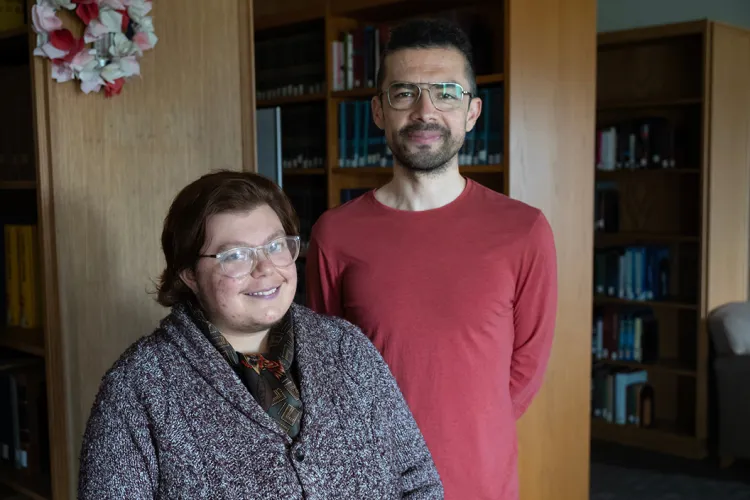Digital Archive Brings to Life College’s Role in Civil Rights Movement

David Obermayer (left), College archivist and records manager, and Roberto Vargas, head of research and instruction services, research librarian for humanities and interdisciplinary studies, were among the contributors to the site.
A team of Swarthmore alumni, staff, and students recently developed the oral history archive "Swarthmore, Student Activism, Civil Rights, 1960-1966." The site focuses on the people and events of those times, but it goes well beyond nostalgia.
“It’s a reminder that the civil rights movement was perhaps the most inspiring and successful movement for social change in U.S. history,” says Daniel Pope ’66, a retired American historian and a contributor to the site. “We have to fight back against the forces seeking to stoke racial hatred and injustice today, and recalling the '60s civil rights movement should help us.”
The site chronicles Swarthmore students who actively aligned themselves with the civil rights movement. Many supported community-based activism and demonstrations in nearby Chester, Pa., and in Cambridge, Md. Others worked with the American Friends Service Committee and with Black community organizers in Tennessee.
The collection includes interviews with 29 alumni from class years 1962 through 1967 who participated broadly within the civil rights movement. Among those experiences, three worked for the Student Nonviolent Coordinating Committee (SNCC), and one participated in a Freedom Ride.
In addition to oral histories, the site offers physical and digital material related to the civil rights movement, says Roberto Vargas, head of research and instruction services, research librarian for humanities and interdisciplinary studies, and site contributor.
It arose from a Class of 1966 reunion panel that caused alumni to “reflect on the need to collect and organize a collective Swarthmore memory about the student involvement in the movement,” says Carl Abbott ’66, a retired historian and site contributor.
“We are keen for this time of activism to be more visible to current students, and hope that this might inspire them to continue in the tradition of work for social justice in Chester and more broadly,” says Tom Webb ’66, a professor emeritus of geological sciences at Brown and site contributor.
The contributors aspired to create a resource as useful and impactful as the College’s "Black Liberation 1969 Archive," and approached Swarthmore Libraries staff for help. It was a big lift: The project required conducting oral history interviews, doing significant networking among alumni, transcribing interviews, designing and creating the site, scouring the College Archives for historical materials, writing content, and more, says David Obermayer, College archivist and records manager and site contributor.
“The alumni bring a lot of networking abilities and lived historical memory,” says Obermayer. “Library staff have lent a lot of practical knowledge and leadership, and all of the students who worked on the project have been enthusiastic and thoughtful in connecting Swarthmore's past to its present.”
“My takeaway is how much each student, each historical event, and each College experience contributes to Swarthmore’s overall narrative,” says Guin Mesh ’19, who helped design the site. “Working with [the archive] provided me insight into how an institution’s history is both created and retained.”
In the introduction to the site, the contributors note the “ongoing and renewed struggle” around systemic racism in the U.S., and present archive materials “in solidarity with Black communities” in Pennsylvania, Maryland, and Tennessee. The perspectives in the archive are meant to enrich understanding of how liberal arts institutions participated in the civil rights movement — not to “center or privilege these perspectives,” the contributors write.
“The collective actions that comprise what we now know of as the civil rights movement were centered in the Black communities with the most at stake, often far from ivory towers,” they add. “This project documents how these struggles galvanized a campus community.”
For Obermayer, working on the project highlighted how committed Swarthmore students have been to “turning their ideas and ideals into tangible action,” whether organizing at Swarthmore, tutoring in Chester (as Webb did), or participating in civil disobedience.
“That’s something that I’ve seen resonate with students today,” he says.
Katie Knox ’22, who helped to implement the website, hopes that the project helps make civil rights narratives more accessible as part of Swarthmore’s living history.
“And that current students find inspiration and cross-generational solidarity in acting against injustice,” Knox says.



